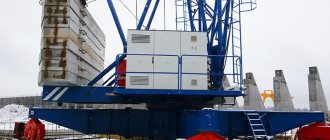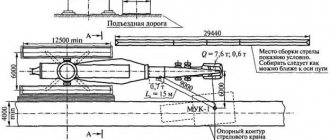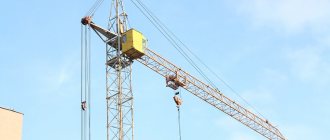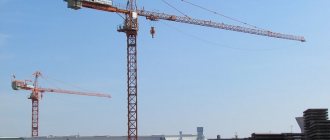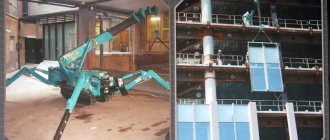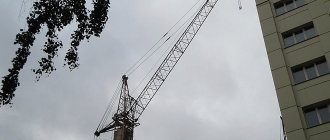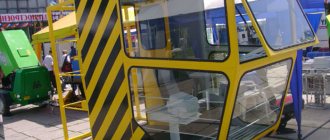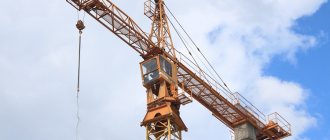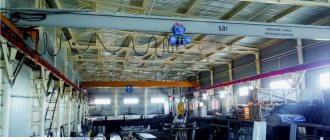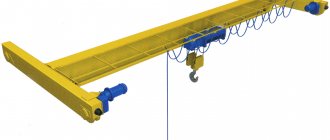To perform a wide range of construction work, special equipment is used, which is characterized by different load capacities and heights. Thanks to this, it is possible to erect buildings of various levels of complexity in a short time. In this regard, it is necessary to consider all the nuances regarding how a tower crane is assembled at a construction site. This process includes several successive stages. To better understand the situation, it is recommended to watch a video of how a crane is assembled at a construction site.
installation, installation at a construction site, lifting construction, industrial, support
On construction sites, mechanisms of different heights and load capacities are used. The technology makes it possible to erect buildings in a short time; before starting work, specialists assemble the tower crane.
Preparation
Tower cranes are brought to the construction site in disassembled form, then workers assemble them on site. The structures are heavy, so the site must be prepared before installation.
The mechanism consists of the following parts:
- Tower.
- Cabin designed for the driver.
- Console. It is necessary for counterbalance.
- Arrow. Load-lifting mechanism.
First, the place where the unit will stand is leveled. To make the structure more stable, the surface is filled with concrete. Grounding is required and electricity is supplied to the site.
You can install a construction crane using a truck crane, but it must be delivered to the site. Convenient access routes to the construction site should be determined in advance.
How to install taps
Installation of cranes is a fairly simple matter that does not require much time and effort. First, workers build a pedestal; it is necessary to install the mechanism. A tower structure is installed on it and secured securely.
An auxiliary crane is used to move the slewing support mechanism into place and fix it in place. After this, workers move on to building up the remaining parts of the structure. This is a tower, a rotating platform, a device for raising and lowering a load, a mechanism for changing the boom reach.
The individual sections of the lift are moved and assembled using the mechanism's own boom. This allows you to quickly increase the height of the device.
The work uses a mounting device, which is a single frame structure. It differs in that it has a removable front part. The mounting device is necessary both for assembly and further operation of the mechanism.
The assembly of the tower crane is carried out using the control panel of the mounting structure, and an auxiliary remote control panel is also used in the work. Along with assembling the device, workers can install support cranes.
Industrial lifting devices at a construction site can reduce the time required to complete work. The house under construction will be completed in just a few weeks.
Checking correct installation
Regular checks and preventive maintenance are the key to trouble-free operation of the mechanism. Wear and deterioration can be observed on mechanisms that have been in use for many years. Under extreme loads, such equipment fails.
An extraordinary technical inspection is necessary after installing the lifting device at a new workplace. During the technical inspection, the operation of mechanical and electrical equipment, safety devices, brake systems and control units, as well as alarms is checked.
During a full inspection, the following will be checked:
- What condition is the metal structure in? The condition of its welded joints is taken into account. Experts look for tears, deformations, rust and other damage. They check the condition of the cabins, stairs, platforms and guardrails.
- The technical condition of the hook and suspension parts, taking into account the degree of their wear.
- How the cargo ropes are secured, their condition.
- Appearance of blocks and fastening elements. Suspension components must be checked.
- Grounding of an electric tap powered from an external network.
- The relationship between the counterweight mass and the ballasts of a tower crane. The obtained values are compared with the numbers indicated in the passport.
When installing cranes and carrying out inspections, they are guided by the information specified in the instructions. The document is drawn up by the manufacturer of the tower mechanism.
specmahina.ru
Preparatory work
To properly understand how a crane is assembled on a construction site, you need to familiarize yourself with its design. So, how does a crane appear on a construction site? Due to its heavy weight, this special equipment is delivered to the construction site in a disassembled state. Each part is assembled on site, on a previously prepared site.
The design of a standard tower crane includes the following elements:
- A tower resting on a strong and powerful base, equipped with a running trolley capable of moving along rail tracks.
- Cabin for the crane operator.
- Console for counterweight.
- The lifting mechanism is a boom.
A tower crane has several important mechanisms responsible for moving the hook, rotating the tower head, moving the trolley, and raising and lowering the hook. Before a tower crane is erected for construction work, the site must be prepared.
- First of all, the site is leveled, and the site is additionally concreted to ensure stability.
- At the next stage, grounding is carried out and the electrical network is connected to the construction site.
To install a tower crane, a truck crane is usually used, which must be delivered to the work site in the most convenient and thoughtful way.
How to assemble a tower crane - Construction Blog
Today, the cranes used in the construction of modern skyscrapers cannot be transported fully assembled. They are delivered to the construction site disassembled (equipment elements are transported using tractors).
To assemble this machine, first prepare a place convenient for installation and put it in order. Then a source of electricity is installed (or cables are laid from it), and rails are installed to ensure the movement of the crane during its operation (required if the construction radius exceeds the length of the boom).
Introduction
In ancient times, the only lifting means were rope and the physical strength of people, which is probably why builders could not boast of erecting high-rise buildings.
Nowadays, modern technology is used on construction sites, which allows construction to be carried out in short lines and buildings of any height to be erected. It is difficult to imagine even a single construction job without a tower crane; such cranes differ in lifting capacity, height and many other indicators.
Today, many crane manufacturers present their lifting devices to consumers. Among them, potain cranes are considered quite popular, which are actively used by many construction companies.
Assembly steps and precautions
Typically, work begins using a remote control panel for electrical circuits to protect the construction team from unforeseen incidents. When the tower is installed on the mounting stand, the spacers are slightly raised and the enclosing elements of each block are mounted.
Next, the mounting rack is activated, and only then is a trolley driven along the rails, securing the running frame to the tracks. The frame is equipped with a counterweight on the platform, then the boom “head” is suspended using a cargo rope. All that remains is to raise the crane tower and connect the boom head to its body.
Once the crane is in place, the boom is raised and power is connected to the control panel in the cab. Then they connect the lighting necessary to operate the crane at night, and check the operation of all equipment systems. In addition, the assembled crane is re-checked for compliance with technical standards and legislation.
Upon completion of inspections and test operation of the crane, installers are allowed to work with it.
Preparing for installation
Tower cranes are quite large structures; for this reason, the lifts are delivered to the place of use in disassembled form and are assembled and installed there.
In order to install a crane, first of all you should prepare the area, that is, level the place where you plan to install the lifting device; many construction companies even make a concrete pedestal for greater reliability and stability of the structure.
Additionally, they make grounding and conduct electricity, determine access routes and deliver an auxiliary truck crane, which will take part in the assembly of the tower crane.
Personal observations
Once upon a time I was interested in how tower cranes are assembled for the construction of tall buildings. One fine day, while walking around a construction site with a camera, I accidentally witnessed this process and took some photographs.
It turned out that the crane assembles itself. Using third-party equipment, only the foundation of the crane and its top are installed. The rest is better seen in pictures than in words.
1. The foundation with the lower part of the tower (in this photo 3 or 4 sections of the tower are already attached to it) is temporarily connected to the upper part (with the cabin and boom) using an assembly device. Here, the next section of the tower stands in the assembly device, ready for installation, and the crane holds another section on the boom as a counterweight until its upper part is rigidly fixed to the base.
2. The assembly device is equipped with jacks, it is slightly wider than the crane tower and can be moved upward along it. In this photo, compared to the previous one, it has already risen to the height of one section of the tower, creating a place inside itself for mounting this section.
3. Three men “with the help of a sledgehammer and some mother” push the tower section into place and secure it.
4. Now the section that was used as a counterweight can be placed on the assembly device.
5. And take the next section, which will be used as a counterweight in the next step.
6. And then begins a fairy tale about a priest who had a dog. In this photo the crane is in exactly the same condition as in the first photo, but one more section higher. And everything is repeated according to the same algorithm.
7. The assembly device rises up the tower again.
8. Again, three men “with the help of a sledgehammer and some mother” push the next section of the tower into place.
9. And the crane became one more section higher. I didn’t take pictures of another iteration of the cycle, I was tired of it. ?
Mounting principles
The first step in assembling a tower crane is to install the tower structure on the prepared pedestal.
Next, using an auxiliary truck crane, the slewing support structure is secured, and the remaining components are attached to it.
Next, to increase the height of the structure, they use its own boom, which helps move and mount individual sections of the lift. An important device during operation, as well as during further use, is the mounting device, which is an integral frame structure, the front part of which is removable.
The tower crane is mounted using a remote control for the mounting structure and an additional remote control.
In general, we can safely say that lifting devices are installed quite simply, without spending a lot of time, but both time and power resources are significantly saved when using such cranes, which make it possible to erect a high-rise building in just a few weeks.
Winches equipped with strong cables are used. By skillfully manipulating these lifting mechanisms, workers carefully lift the structure off the platform and into a vertical position. Then the crane is strengthened and fixed, power cables are connected to it, without which the operation of the device is impossible. If a friendly and well-coordinated team of professionals is involved in the work, you can complete the installation of a crane in part of a working day.
If a construction site needs not a standard, but a taller crane, the work is done a little differently.
First, a concrete slab is installed, which becomes a reliable foundation. The first section of the crane is tightly mounted into the slab. The next sectional element, called the mounting frame or “telescope,” is lifted by a truck crane.
This second section is slightly larger in size than the first and subsequent ones. The boom and operator's cabin are attached to it.
Now it becomes possible to consistently increase the height of the entire structure. While driving the machine, the operator assembles his future crane himself. Workers place the next structure inside the second, auxiliary section.
After this, each new section is lifted to the required height using winches and secured. This continues until the height of the tower crane reaches the specified value. If in the future the tap needs to be grown a little more, the whole process is repeated.
Video of how new sections are installed on a tower crane
Sources:
https://www.122kran.by/stati/montazh-krana/
https://www.kakprosto.ru/kak-832503-kak-na-bashennyy-kran-ustanavlivayut-novye-sekcii
https://glavspec.ru/kak-sobirayut-bashennyiy-kran.html
https://one-in.livejournal.com/156914.html
blog-potolok.ru
How to assemble a tower crane
In ancient times, the only lifting means were rope and the physical strength of people, which is probably why builders could not boast of erecting high-rise buildings.
Nowadays, modern technology is used on construction sites, which allows construction to be carried out in short lines and buildings of any height to be erected. It is difficult to imagine even a single construction job without a tower crane; such cranes differ in lifting capacity, height and many other indicators.
Today, many crane manufacturers present their lifting devices to consumers. Among them, potain cranes are considered quite popular, which are actively used by many construction companies.
Preparing for installation
Tower cranes are quite large structures; for this reason, the lifts are delivered to the place of use in disassembled form and are assembled and installed there.
In order to install a crane, first of all you should prepare the area, that is, level the place where you plan to install the lifting device; many construction companies even make a concrete pedestal for greater reliability and stability of the structure.
Additionally, they make grounding and conduct electricity, determine access routes and deliver an auxiliary truck crane, which will take part in the assembly of the tower crane.
The design itself consists of several components, including:
- a tower that consists of several sections;
- slewing support;
- driver's cabin;
- console providing counterweight;
- boom and mounting fixture.
Mounting principles
The first step in assembling a tower crane is to install the tower structure on the prepared pedestal.
Next, using an auxiliary truck crane, the slewing support structure is secured, and the remaining components are attached to it.
Next, to increase the height of the structure, they use its own boom, which helps move and mount individual sections of the lift. An important device during operation, as well as during further use, is the mounting device, which is an integral frame structure, the front part of which is removable.
The tower crane is mounted using a remote control for the mounting structure and an additional remote control.
In general, we can safely say that lifting devices are installed quite simply, without spending a lot of time, but both time and power resources are significantly saved when using such cranes, which make it possible to erect a high-rise building in just a few weeks.
Tweet
glavspec.ru
Preparing for installation
Installation of any heavy special equipment is possible only on a prepared site. Therefore, before you find out how a crane is assembled at a construction site, you should consider the preparatory work. The site must be leveled and cleared of construction debris, etc., and fenced in accordance with the rules. If we are talking about rail technology, then first, crane tracks are laid on a pre-concreted area (ground or above ground, depending on the size of the crane and construction conditions). The rails are equipped with movement limiters on both sides.
All manipulations with parts are carried out with a truck crane or, if there are railway tracks in the installation area, with a railway crane. Upon completion of installation, all mechanisms are run in, after which the crane is tested under load . Only after this can the equipment be put into operation.
Be sure to read: Truck cranes Galician: model range, technical characteristics
How to assemble a construction tower crane
A little atypical post for me, but it happened by chance. I wanted to share these photos several years ago, but I completely forgot about them. And now, due to the complete lack of free time, I did not have time to prepare another photo story about photo travel, and in search of prepared but unpublished photographs, I accidentally came across this faucet.
Once upon a time I was interested in how tower cranes are assembled for the construction of tall buildings. One fine day, while walking around a construction site with a camera, I accidentally witnessed this process and took some photographs.
It turned out that the crane assembles itself. Using third-party equipment, only the foundation of the crane and its top are installed. The rest is better seen in pictures than in words.
[← | →]1. The foundation with the lower part of the tower (in this photo, 3 or 4 sections of the tower are already attached to it) is temporarily connected to the upper part (with the cabin and boom) using an assembly device. Here, the next section of the tower stands in the assembly device, ready for installation, and the crane holds another section on the boom as a counterweight until its upper part is rigidly fixed to the base. [← | →]2. The assembly device is equipped with jacks, it is slightly wider than the crane tower and can be moved upward along it. In this photo, compared to the previous one, it has already risen to the height of one section of the tower, creating a place inside itself for mounting this section. [← | →]3. Three men “with the help of a sledgehammer and some mother” push the tower section into place and secure it. [← | →]4. Now the section that was used as a counterweight can be placed on the assembly device. [← | →]6. And take the next section, which will be used as a counterweight in the next step. [← | →]7. And then begins a fairy tale about a priest who had a dog. In this photo the crane is in exactly the same condition as in the first photo, but one more section higher. And everything is repeated according to the same algorithm. [← | →]8. The assembly device rises up the tower again. [← | →]9. Again, three men “with the help of a sledgehammer and some mother” push the next section of the tower into place. [← | →]10. And the crane became one more section higher. I didn’t take pictures of another iteration of the cycle, I was tired of it.
PS. These are old photographs, this crane no longer exists. In its place stands one of the buildings of the house in which I live.
one-in.livejournal.com
Crane dismantling process
Videos showing how a crane is dismantled are not as impressive as those showing the assembly process. It is impossible to dismantle a construction crane in the reverse order by disassembling sections using a boom. Cranes do not disassemble themselves. For this purpose, special shooting cranes are used, higher than those being dismantled. They are driven to the site after construction is completed specifically to perform this operation.
In general, dismantling a tower crane is more difficult and takes longer than, for example, a gantry or overhead crane. This is due both to the peculiarities of its design and to the fact that by the end of the work the area around it is built up and there is little room left for maneuvering the equipment. Typically, disassembling the crane takes about a week.
When working on small construction sites, you can use cranes that can be dismantled without resorting to additional equipment. This is convenient and significantly reduces costs, but is only available in low-rise buildings.
How cranes are installed at a construction site: installation, assembly and extension of a tower crane
Yesterday I wrote about a crane falling, but today I thought: why not talk about the opposite process - how they are installed. Well, a little about the radio-controlled toy crane that I bought for the children a few years ago.
Once upon a time in childhood, I was not even 7 years old, I was in the hospital, with the simultaneous removal of my tonsils and adenoids. Opposite my window there was construction going on, and they were just about to install a tower crane there. But, unfortunately, on the day when it was supposed to be directly increased, I was taken away for surgery. In general, to put it mildly, it didn’t go very well, after which I dropped out of this life for a couple of days. Then a lot of nasty things happened related to this (after which I began to be very wary of all doctors) - but that’s another story, and at that moment it was important that I never saw the installation of the faucet itself, which I talked about for a very long time later regretted. Years passed, but for some reason I still had no luck with this - all the cranes around me grew by themselves, and I could not catch the moment of the actual assembly. And only after finishing school, I found special literature that described in detail how it actually grows on its own. Below the cut I’ll tell you and post a few videos of how it all looks in real life.
In general, everything turned out to be very simple - using an external wrap-around structure with auto-hydraulic lifts called a “telescope”. The crane lifts itself and drives another section-span about 3 meters high into its vertical core.
Well, considering that YouTube has now appeared, in order to observe and imagine the whole process, now you don’t even need to specially seize the moment and look into books. It is now possible to see even an animation of the tower crane installation process:
The only thing I would like to note is that on imported cranes such as San Marco or Liebherr, the telescope is installed in the upper sections, and in the case of our KB-308 cranes, the telescope is located on the contrary, next to the base.
Here, for example, we are putting together San Marco piece by piece (animation, almost the same as the previous video, but a broader overview):
Well, similarly - Liebherr (already live):
And this is ours, KB-308 - pay attention to where additional sections are supplied from and to
Well, the whole process from start to finish with comments:
And now - to the toys. I bought my children a long time ago, three or four years ago, a radio-controlled Dickie mega-crane toy, almost taller than themselves:
The thing is simply wonderful: 120 cm high, 6 degrees of freedom - it can raise/lower a load, the platform moves back and forth along the boom, and unlike its similar 110 cm brother (and the updated version) - it can rotate around its axis at full 360 degrees. A. The boom can also be fixed in several positions - both horizontally and at an angle to the horizontal - and raised slightly. So, perhaps only without a telescope extension
In general, if there is a need to involve dad in playing with children, then this thing is simply a must have! I know from myself that you can’t pull it by the ears. You just need to remember to put the load in the counterweight box, otherwise it may fall over when lifting the load.
The only negative is that since it is very actively used in many games, and is made of plastic, it breaks very quickly: after just half a year, the plastic couplings holding the arrow in their hook-shaped places almost straightened out (they had to be duplicated with a normal cord-rope), after another three or four months from heavy load - the fastening in the base broke (drilled and secured with nylon ties), during one of the turns - the plastic axis of the turning mechanism gear broke (drilled and inserted a steel screw, filled with epoxy), and now, it seems, it’s coming three thousand teeth of the gear that winds the cable thread (haven’t looked at what’s there yet). But if you have more or less hands, then everything can be fixed. So far there have been no major breakdowns.
However, even if we give our children titanium alloys, they will still get hurt. I'm still surprised how the bike holds up
1
chewriter.ru
How tower cranes are assembled – Berjek
Due to the fact that my activity was not related to construction and installation work, but, unfortunately, was connected with theoretical mathematical crap and computers, for the last few weeks I was tormented by the question of how tower cranes are assembled, inspired by the contemplation of a tower crane between the railway station Leninsky Prospekt and Leninsky Prospekt metro station. Google responded to this with a large number of links with text answers:
link times" Installation of the first three sections of the tower is carried out by a jib self-propelled tower crane with a lifting capacity of at least 16 tons at an outreach of 7 m and with a lifting height of up to 33 m. Further extension of the tower, installation of links securing them to the building, as well as dismantling of tower sections and links is carried out by mechanisms crane."
Increasing the height of the tower is carried out as follows:
1. The tower section is suspended on the hook suspension of the mounted crane at an overhang that balances the retractable part of the crane.
2. The mounting device with the retractable part of the crane rises along the tower until an opening is formed for inserting the mounted section of the tower.
3. When the cargo winch is turned on for lifting and the cargo trolley is moved, the section with the rollers mounted on it is installed on the guides of the mounting device.
4. After removing the slings, the mounted section is pushed into the tower opening.
5. The cargo trolley moves to the installation reach, and the next section, prepared for installation, is suspended on the hook clip.
6. The mounting device is lowered from the interception stop and then lowered so that the centering pins of the upper section of the tower enter the mounting holes of the mounted section. The rollers from the mounted section are dismantled. The belts of the upper and mounted sections are joined. Subsequent sections are mounted in the same way. The KB-473 tower crane has versions that differ in lifting height and boom reach. The basic model has versions with booms of 45, 40, 35 and 30 m with a maximum lifting height of 162.4 m. The KB-474 tower crane has versions that differ in boom reach of 55, 50, 45, 40 and 35 m with a maximum height lift 222.4 m. "
There is also an option with a hydraulic lift - the top of the crane with a boom is attached to the lift and rises to the height of the section, which slides into the resulting opening. Next, the lower part of the section is attached to the upper part of the previous one, after which the hydraulic lift locks on the newly installed section and begins to lift the top to the next level, etc.
Oddly enough, they push it to the top and lift it with another crane.
From this link I still didn’t understand how exactly they are assembled, so I started looking for somewhere to see how it’s done, and here’s how it’s done:
This is how they assemble a crane, not interestingly (simply lifting parts with a truck crane), but working in detail and actively with sledgehammers: part 1
part 2
part 3
part 4
part 5
Here the assembly is interesting, short and tasteful, it lifts itself up by inserting new sections inside.
And there is also a model of such a curve:
And the cranes are falling:
And not only in Russia and not only towers
these are the pies, I gained respect for the designers of these ingenious structures.
berjek.livejournal.com
